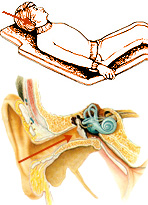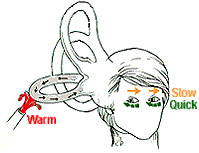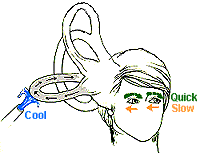|
Biological Signals Acquisition |
EOG tests >
Caloric testing |
| |
Pathological
modification of nystagmus patterns is an
important clinical aid to the diagnosis of
lesions to the vestibular system. |
| |
As you have seen, vestibular nystagmus can be elicited by
rotating a subject in a swivel chair. In the
clinic, the vestibular nystagmus may also be
elicited using a caloric stimulus. This procedure
is referred to as caloric testing.
The test takes advantage of the fact that the
sensory organ of the inner ear, which senses
horizontal head motion, bulges laterally towards
the middle ear space. |
| |
 |
| In
the caloric test, the sensory organ on one side
of the head is locally cooled (or warmed) by
pouring cool (or warm) water into the external
auditory meatus. By tilting the head back to the
proper angle, a warm water stimulus will cause
convection currents in the fluid filled
vestibular end organ resulting in neural
excitation of the central vestibular pathways. |
|
Using
warm water in the right ear, an ocular nystagmus
is evoked in which the slow phase is towards the
left side, and conversely the fast phase is
towards the right. Cold water will have the
opposite effect. (Note: the sensors on the right
and left sides of the head are normally excited
by rightward and leftward head motion
respectively). The patterns of nystagmus evoked
by this artificial stimulus provide important
clinical clues regarding the integrity of both
peripheral and central vestibular function. An
important advantage of this type of caloric
testing over rotational testing is that the
peripheral vestibular apparatus on each side of
the head can be examined independently.
Click here to see the experiment |
 |
 Adapted
from Brookler KH, in Lee KJ, Stewart C, eds. Ambulatory
surgery and office procedures in head and neck
surgery. Philadelphia: Grune &
Stratton,1986. |
|
To continue with the next
topic, Artifacts, click here |